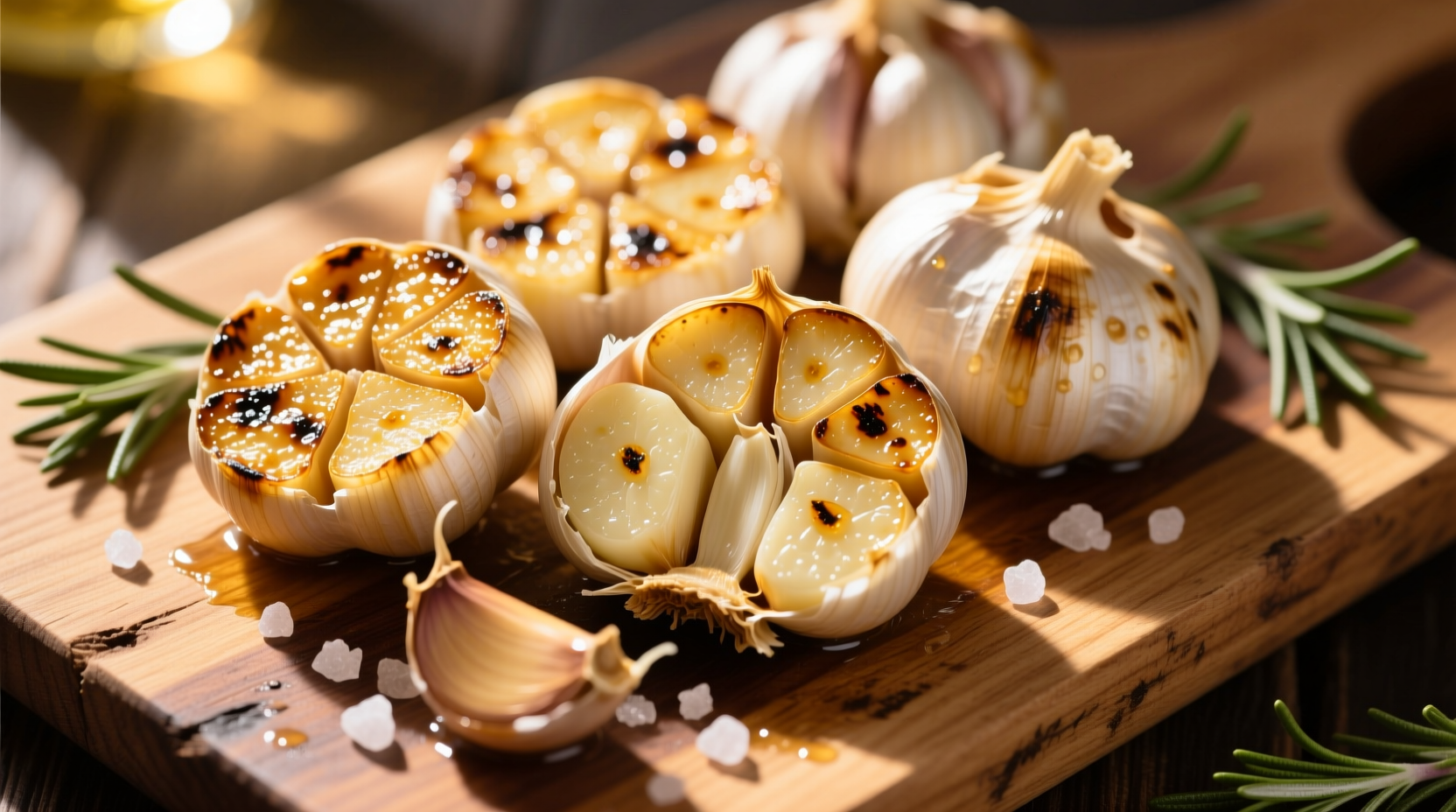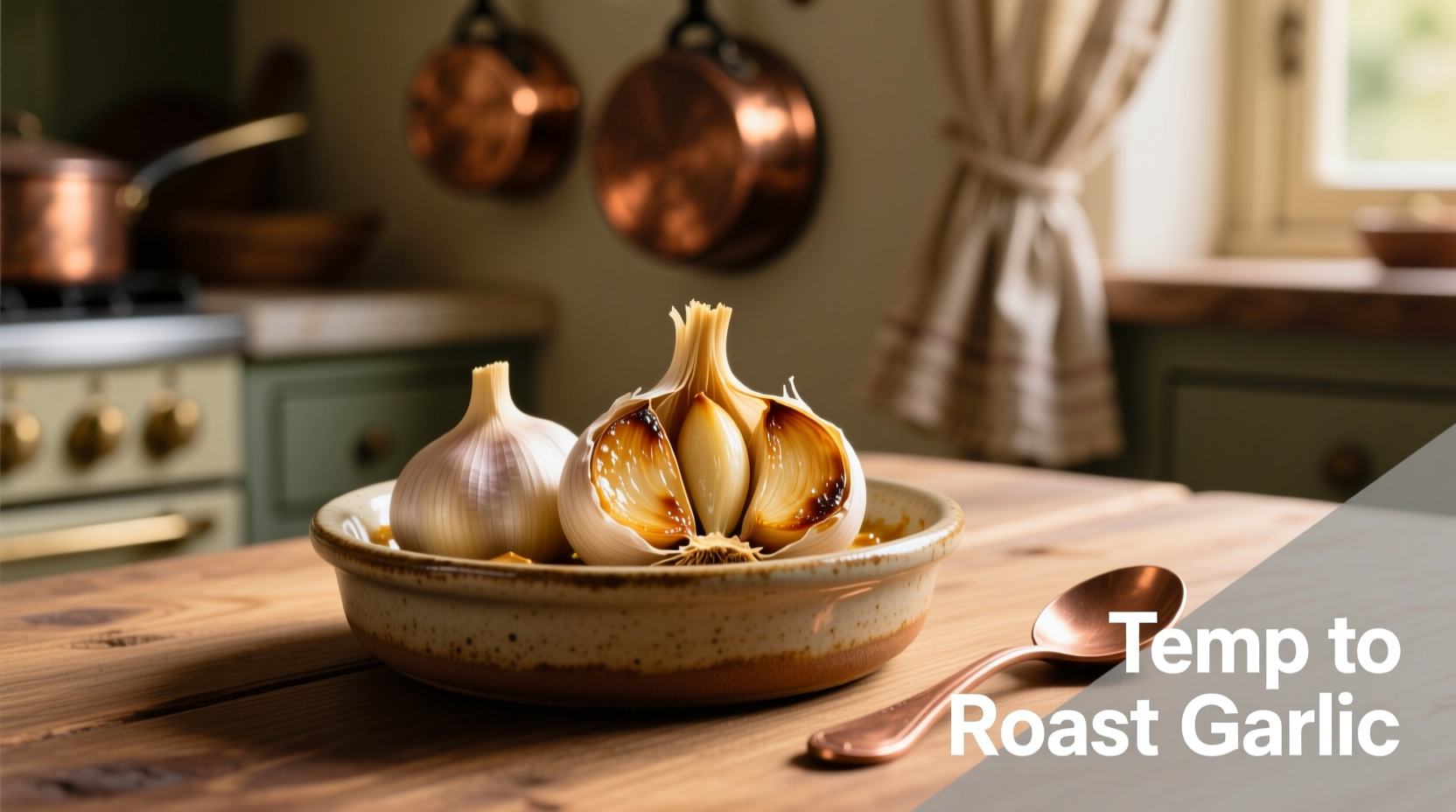The ideal temperature to roast garlic is 375-400°F (190-205°C) for 30-40 minutes, producing sweet, mellow cloves with a creamy texture. This temperature range allows for optimal flavor development without burning the garlic.
Roasting garlic transforms its sharp, pungent flavor into something sweet, nutty, and complex—perfect for elevating sauces, spreads, and roasted vegetables. But getting that perfect balance of caramelized sweetness without burning requires precise temperature control. Whether you're a beginner cook or a seasoned kitchen enthusiast, understanding the science behind roasting temperatures will help you achieve consistently delicious results every time.
Why Temperature Matters for Roasted Garlic
Garlic contains sulfur compounds that create its signature sharpness. When exposed to heat, these compounds break down through chemical reactions. The Maillard reaction (occurring around 285-320°F/140-160°C) and caramelization (starting around 320°F/160°C) transform these compounds into hundreds of new flavor molecules, creating that rich, sweet profile we love in roasted garlic.
According to research published in the Journal of Agricultural and Food Chemistry, roasting garlic at temperatures below 350°F (177°C) preserves more of the beneficial allicin compounds while still developing complex flavors. Higher temperatures accelerate flavor development but increase the risk of burning.
| Temperature Range | Time Required | Flavor Profile | Best For |
|---|---|---|---|
| 325-350°F (163-177°C) | 40-50 minutes | Mild, subtle sweetness | Delicate sauces, subtle flavor enhancement |
| 375-400°F (190-205°C) | 30-40 minutes | Balanced sweet-nutty flavor | Most applications, spreads, dressings |
| 425°F+ (218°C+) | 20-25 minutes | Intense caramelization, slight bitterness | Robust dishes, meat rubs |
Step-by-Step Guide to Perfectly Roasted Garlic
Preparing Your Garlic
Start with fresh, firm garlic bulbs. Remove the outer papery skin but leave the cloves intact. Slice about 1/4 inch off the top of the bulb to expose the cloves. Drizzle with 1-2 teaspoons of olive oil, making sure it seeps between the cloves. This oil barrier prevents drying and promotes even heat transfer.
Choosing Your Roasting Method
Oven Roasting (Most Reliable Method)
Place prepared garlic bulbs on aluminum foil, drizzle with oil, and wrap loosely. Roast at 375-400°F (190-205°C) for 30-40 minutes. The foil creates a steam environment that helps cook the garlic evenly while preventing burning. Check for doneness by gently squeezing a clove—it should feel soft and yield easily.
Air Fryer Method (Faster Option)
For those using an air fryer, set to 350°F (177°C) for 15-20 minutes. The circulating hot air cooks garlic more quickly, so check frequently after 12 minutes. This method works well for individual cloves but requires careful monitoring to prevent over-browning.
How to Tell When Garlic Is Perfectly Roasted
Don't rely solely on time—use these visual and tactile cues:
- Color: Cloves should be golden brown, not pale yellow or dark brown
- Texture: Should feel soft when gently pressed, like softened butter
- Aroma: Sweet, nutty fragrance without any acrid or burnt notes
- Internal temperature: 165-175°F (74-80°C) when measured with a probe thermometer

Avoiding Common Roasting Mistakes
Even experienced cooks make these temperature-related errors:
Burning the Garlic
Garlic burns easily above 400°F (205°C). The USDA Food Safety and Inspection Service notes that burning creates acrylamide, a potentially harmful compound. To prevent burning:
- Never roast above 425°F (218°C)
- Use foil wrapping for oven roasting
- Check garlic every 5-10 minutes during the final cooking stage
Uneven Roasting
Smaller cloves cook faster than larger ones. Solution: Separate cloves of similar size before roasting, or arrange larger cloves toward the outside of your baking dish where heat is more intense.
Creative Ways to Use Perfectly Roasted Garlic
Once you've mastered the ideal roasting temperature, try these professional chef techniques:
Garlic Infused Oil
After roasting, submerge cloves in high-quality olive oil. The residual heat extracts additional flavor. Store in the refrigerator for up to 2 weeks. According to the National Center for Home Food Preservation, this method creates a safer product than raw garlic in oil, which can support botulism growth.
Compound Butter
Mix 4-6 roasted cloves with 1/2 cup softened butter, a pinch of salt, and fresh herbs. Roll into a log using parchment paper and refrigerate. Perfect for finishing steaks or melting over vegetables.
Flavor-Boosting Paste
For maximum flavor impact, mash roasted garlic with a small amount of the roasting oil until smooth. This paste incorporates more evenly into sauces and dressings than whole cloves.
Temperature Adjustments for Special Dietary Needs
For those following specific dietary protocols:
- Low-FODMAP diets: Roast at 350°F (177°C) for 45 minutes to further break down fructans
- Raw food diets: While not technically "roasted," dehydrating at 115°F (46°C) for 12-18 hours creates a similar flavor transformation without cooking
- Keto diets: Higher temperature roasting (400°F/205°C) maximizes caramelization while keeping net carbs low
Storing and Preserving Roasted Garlic
Proper storage maintains your carefully roasted garlic's quality:
- Refrigerate in an airtight container with its oil for up to 10 days
- Freeze whole cloves in ice cube trays covered with oil for up to 6 months
- For long-term preservation, pressure can according to USDA guidelines
Remember that properly roasted garlic should never taste bitter or acrid—that's a sign of burning. When stored correctly, the mellow, sweet flavor will enhance your dishes for weeks to come.
Frequently Asked Questions
Can I roast garlic at 350°F instead of 400°F?
Yes, roasting garlic at 350°F (177°C) takes 40-50 minutes but produces a more subtle, delicate flavor. This lower temperature preserves more of garlic's beneficial compounds while still developing sweetness. It's ideal for dishes where you want garlic flavor without overwhelming other ingredients.
How do I prevent roasted garlic from burning?
Wrap garlic bulbs in foil with 1-2 teaspoons of olive oil before roasting. The foil creates a steam environment that prevents drying and burning. Check garlic every 10 minutes during the final cooking stage, and never exceed 425°F (218°C). Smaller cloves cook faster, so separate by size before roasting.
What's the difference between roasted and caramelized garlic?
Roasted garlic undergoes both Maillard reaction (285-320°F/140-160°C) and caramelization (320°F+/160°C+), creating complex flavors. Caramelized garlic specifically refers to the sugar breakdown process that occurs above 320°F (160°C). Properly roasted garlic has both reactions, while burnt garlic has exceeded the ideal temperature range for beneficial chemical transformations.
Can I roast garlic without oil?
Yes, but oil helps transfer heat evenly and prevents drying. For oil-free roasting, wrap garlic tightly in foil with 1-2 tablespoons of water or vegetable broth. Increase roasting time by 5-10 minutes and check frequently to prevent drying. The results will be slightly less rich but still flavorful.
How long does roasted garlic last in the refrigerator?
Properly stored roasted garlic (submerged in its oil in an airtight container) lasts 7-10 days in the refrigerator. For longer storage, freeze cloves in oil for up to 6 months. The National Center for Home Food Preservation recommends discarding any garlic stored in oil at room temperature after 4 hours due to botulism risk.











 浙公网安备
33010002000092号
浙公网安备
33010002000092号 浙B2-20120091-4
浙B2-20120091-4